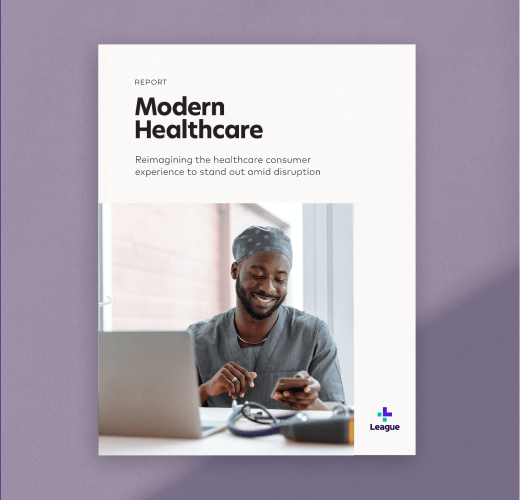Summary
- Simple portals are no longer enough – consumers demand personalized, integrated, on-demand healthcare experiences.
- The next-generation digital front door creates connected experiences tailored to each healthcare consumer’s medical history, health information, and self-reported data.
- Excellent healthcare CX (consumer experience) is dynamic and fosters improved engagement, trust, and health outcomes by closing care gaps.
*UPDATED 2023*
The healthcare industry is no stranger to the digital front door. For years, the term has been used to describe bringing systems and point solutions together into one easy-to-access, digital location for healthcare consumers. This type of platform, however, serves primarily as a portal, which is no longer enough to satisfy current consumer expectations.
Healthcare consumers now want a connected and intelligent ecosystem like what League, Highmark Health and Google Cloud launched this year — a system personalized for each individual, that anticipates their healthcare needs and recommends a next best action. They want to navigate their health journeys according to their unique situations and connect with their clinicians in ways that work well for them and their families. Moreover, consumers still want to accomplish these actions through a seamless and modern digital experience.
The digital front door we’ve come to know—the digital front door 1.0—cannot support this functionality. It serves as a convenient place to log in during an episode of care but does not encourage and guide the consumer throughout their ongoing health journey to maintain wellness and mitigate illness and disease. As evidenced by recent articles coming from major healthcare conferences, not only is the digital front door 1.0 insufficient as a tool for engaging members and patients, most of them lead to basic and disconnected experiences.
So, if the digital front door 1.0 is no longer efficient in meeting healthcare consumers’ demands, what’s next?
The digital front door 2.0: the future of the healthcare consumer experience (CX)
The digital front door 2.0 is powered by an integrated CX platform that creates highly connected, on-demand, personalized health experiences. This next-generation solution connects the consumer to the entire healthcare ecosystem and aggregates information from point solutions, systems and data sources to create uniquely tailored health journeys. These health journeys guide consumers to the right care at the time and deliver proactive health actions based on medical histories, health information and self-reported data.
The digital front door 2.0 takes into account the total healthcare experience, which includes how consumers engage with the healthcare system. It enables direct communication between patients and clinicians, helping to build a relationship of transparency and trust. It also allows seamless communication between consumers and healthcare organizations without relying exclusively on legacy communications, such as text messages or automated phone calls.
What is healthcare CX?
Healthcare CX encompasses the entire scope of interactions and experiences consumers have with health systems, health plans and other organizations within the healthcare ecosystem. A best-in-class healthcare CX is dynamic, personalized, preventive, meaningful, omnichannel and thoughtfully designed to improve navigation, engagement and outcomes.
A best-in-class consumer healthcare experience requires an orchestrated experience that’s connected around patient need.
LAURA WESTERCAMP
Managing Director Life Sciences, Accenture
Why a good healthcare CX depends on the digital front door 2.0
Healthcare consumers commonly experience long appointment wait times, untimely care interventions and poor care coordination. These factors lead to worse health outcomes and a lack of trust between consumers and healthcare systems. The digital front door 2.0 helps deliver a CX that improves upon all of these factors.
It uses data collected from the integrated systems to deliver personalized health activities, check-ins and actionable insights to engage consumers and close gaps in care. From updating insurance information and refilling a prescription, to reporting new symptoms to their clinician and scheduling an appointment, the platform meets consumers where they are to guide them along their personal health journeys.
This impactful CX integration allows consumers to move through the healthcare ecosystem freely. It removes barriers to care and makes it easier for consumers to get the care they need, when they need it.
Benefits of the digital front door 2.0
Investing in an integrated healthcare CX platform offers multiple advantages for both organizations and consumers. The deeper, more predictive form of digital health personalization, combined with a more personal patient and clinician relationship, fosters effective care and better health outcomes. As consumer health shifts from a reactive to proactive model, care affordability and population health also improve.
More affordable care and earlier interventions translate into improved economics for healthcare organizations. This ability to deliver better health outcomes, fewer care delays and more cost-effective care supports long-term growth for both payers and providers.
Across the hundreds of plans, providers and organizations that we’re working with…everyone sees that getting the consumer engaged—not once a year, not once every three years during an episode of care, but on a daily, weekly, monthly type cycle—is the key.
MICHAEL SERBINIS
Founder and CEO, League
The time to transform the healthcare CX is now
Healthcare has been battling an engagement problem for years. Accenture research found two-thirds of Americans have had a negative healthcare experience. Of those who reported poor experiences, 34% said they were less likely to seek medical care in the future, and another 34% said they switched treatment or providers. Others said they stopped their treatment or didn’t pick up their prescription because of poor experiences.
These statistics show how a negative CX is detrimental to healthcare engagement and, consequently, health outcomes. The digital front door 1.0 is no longer enough to improve the CX and encourage habitual engagement. A shift toward the digital front door 2.0, however, can unlock meaningful value across the entire health journey.

Modern Healthcare
Explore how to reimagine your healthcare CX strategy to stand out amid disruption.
